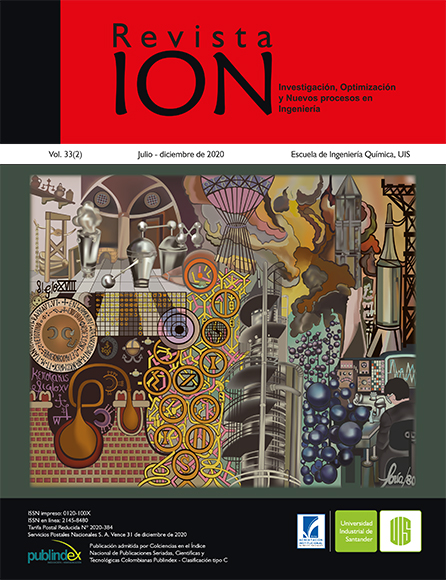Study of back produced HPAM polymer effects on dehydration and clarification cEOR at Ecopetrol S.A.
Published 2020-11-12
Keywords
- Physicochemical Properties,
- Direct and Inverse Emulsions,
- Surface Facilities Production Fluids,
- Enhanced oil Recovery,
- Water Quality
How to Cite
Copyright (c) 2020 Dalje Sunith Barbosa Trillos, Henderson Ivan Quintero Pérez, Alvaro Villar Garcia, Janet Cifuentes Marin, Kelly Margarita Colmenares Vargas

This work is licensed under a Creative Commons Attribution 4.0 International License.
Abstract
Enhanced oil recovery is a process that is used to maximize the volume of hydrocarbons recovered in oil fields. Among the methods of enhanced chemical recovery, the injection of polymers is found seeking to increase the viscosity of the displacing fluid and thus the volumetric sweep efficiency in the reservoir. Regardless of the EOR process used, effective management of the produced fluids is critical to the success of the project. One of the main focus of attention is the uncertainty of the characteristics of the produced fluids, as the polymer passes through the reservoir, in particular, changes in physical and chemical properties due to the adsorption of the compounds in the reservoir and the mechanical and thermal degradation.
In the case of ECOPETROL S.A fields, where the possible expansion of polymer injection projects is currently being considered, a detailed study of the incidence of polymeric residues in producing wells and their downstream effect was required. The research group of the Center for Innovation and Technology - ICP made evident an increase in the efficiency of the dehydration process in the presence of polymer residues, while in the water treatment stage a negative impact on the quality of the separated water was found with the increase of the remaining polymer content, resulting in physicochemical parameters out of the specifications for injection or pouring water.
Downloads
References
[2] Thomas A, Gaillard N, Favero C. Some key features to consider when studying acrylamide-based polymers for chemical enhanced oil recovery. Oil Gas Sci Technol. 2012;67(6):887–902.
[3] Nguyen D, Sadeghi N, Houston C. Chemical interactions and demulsifier characteristics for enhanced oil recovery applications. Energy & Fuels. 2012;26(5):2742-2750.
[4] Walsh J, Henthorne L. Challenges of Water Treating for Chemical Enhanced Oil Recovery. Oil & Gas Facilities; 2012; 9-14.
[5] Al-Mutairi SM, Kokal S.L. EOR Potential in the Middle East: Current and Future Trends. En: SPE EUROPEC/EAGE Annual Conference and Exhibition. 2011 may 23-26; Vienna, Austria.
[6] Chang HL, Zhang ZQ, Wang QM, Xu ZS, Guo ZD, Sun HQ, et al. Advances in Polymer Flooding and Alkaline/Surfactant/Polymer Processes as Development and Applied in the People’s Republic of China. J Pet Technol. 2006; 58(2): 84–89.
[7] Longde S, Xiaolin W, Wanfu Z, Xuejun L, Peihui H. Technologies of enhancing oil recovery by chemical flooding in Daqing Oilfield, NE China. Pet Explor Dev. 2018;45(4):673-684.
[8] Zheng F, Quiroga P, Sams GW. Challenges in processing produced emulsion from chemical enhanced oil recovery-Polymer flood using polyacrylamide. En: SPE Enhanced Oil Recovery Conference. 2011 july 19-21; Kuala Lumpur, Malaysia.
[9] Aguiar JIS, Mansur CRE. The influence of polymer flooding on produced oily water: a review. Brazilian J. Pet Gas. 2016; 10(1): 49-61.
[10] León JM, Castillo AF, Pérez R, Jiménez JA, Izadi M, Méndez A, et al. A successful polymer flood Pilot at Palogrande-Cebu, a low permeability reservoir in the Upper Magdalena Valley, Colombia. En: SPE Improved Oil Recovery Conference. 2018 April 14-18; Tulsa, Oklahoma, USA.
[11] Jiménez R, Castro R, Maya G, Pérez R, Delgadillo C, García H, et al. Análisis comparativo de procesos de inyección de polímeros ejecutados en Colombia. En: Congreso Colombiano del Petróleo organizado por ACIPET. 2017 octubre 18-20; Bogotá D.C. Colombia.
[12] Pérez R, Castro RH, Jimenez R, Maya GA, Leon JM, et al. Mature field revitalization using polymer flooding: Palogrande – Cebú field case. En: SPE Latin America and Caribbean Petroleum Engineering Conference. 2017 may 17-19; Buenos Aires, Argentina.
[13] American Petroleum Institute (API). API RP 63-1990. En: Recommended Practices for Evaluation of Polymers Used in Enhanced Oil Recovery Operations. 1990.
[14] Deng S, Bai R, Chen JP, Jiang Z, Yu G, Zhou F, et al. Produced water from polymer flooding process in crude oil extraction: characterization and treatment by a novel crossflow oil–water separator. Sep Purif Technol. 2002; 29(3): 207-216.
[15] Argillier JF, Henaut I, Noik C, Viera R, Roca Leon F, Aanesen B. Influence of chemical EOR on topside produced water management. En: SPE Improved Oil Recovery Symposium. 2014 april 12-16; Tulsa, Oklahoma, USA.
[16] Chen H, Tang H, Gong X, Wang J, Liu Y, Duan M, et al. Effect of partially hydrolyzed polyacrylamide on emulsification stability of wastewater produced from polymer flooding. J Pet Sci Eng. 2015;133:431-439.
[17] Ma B, Gao B, Yue Q. Study on emulsification stability of wastewater produced by polymer flooding. J Pet Sci Eng. 2013;110:27-31.

